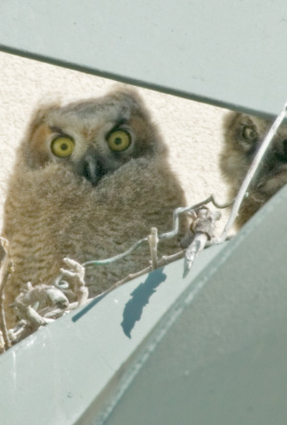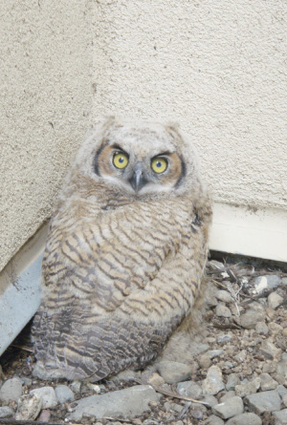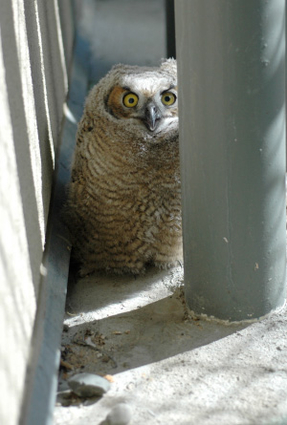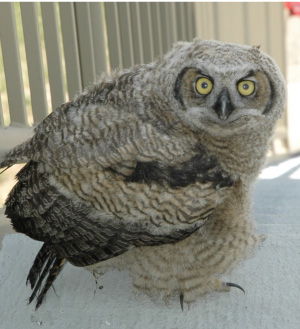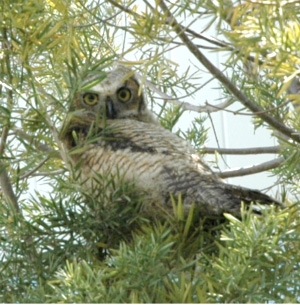Lab gives a hoot about horned owl family blog
This spring a family of Great Horned Owls stole the hearts of many LLNL employees and provided a much-needed diversion from our every day routines.
Although Great Horned Owls are common in this area and occur throughout North America, it is rare to have the chance to follow the progress of a Great Horned Owl family every day. LLNL employees recognized this opportunity and calls and emails poured into LLNL's Environmental Protection Department reporting the latest events at the nest.
April 2, 2009 – An adult Great Horned Owl is observed roosting on the large air ducts on the south side of the NIF facility (Bldg. 581). This is an unusual sight for the middle of the day. Closer observation reveals a nest tucked behind a support beam near the building. The three owlets in the nest appear to be two or three weeks old.
April 8, 2009 – Three juvenile owls and one adult are at the nest. The young owls are eating the remains of a rabbit. Great Horned Owls can have a diverse diet, including small mammals, reptiles and other birds such as geese.
April 16, 2009 – At about four or five weeks old, the owlets are still sporting their downy feathers, but they are starting to grow in the more substantial feathers that make flight possible. It's been a hot week (temperatures reached 90° Fahrenheit). Although we only see one of the adult owls at the nest, both the male and female Great Horned Owl typically care for the young. Plumage alone cannot be used to distinguish male and female Great Horned Owls, but it is likely that the female is the adult owl we see at the nest, and the male is watching from a hiding place nearby during the day. Female Great Horned Owls are larger than the male, and the males have a lower call.
April 17, 2009 – One of the young owls is found on the ground next to the NIF building. The owl appears unharmed. The young owl is able to glide down from the nest at this age, but it is still too young to be able fly. After a call to experts at the Lindsay Wildlife Museum Hospital in Walnut Creek, we determine it is best to leave the young owl on the ground near the nest where its parents can look after it instead of taking the stranded owl to be cared for in the wildlife hospital. NIF maintenance staff and the LLNL wildlife biologist move the young owl into an owl box raised off the ground to protect it from predators. We are able to go home for the evening knowing that we did our best to protect the young owl.
April 18, 2009 – The independent juvenile owl refuses to stay in the safety of the owl box and is found on the ground again. Over the weekend, the juvenile owl is seen on the ground near Inner Loop Road. We question the decision to leave the owl on the ground, but stay the course and control our urge to "rescue" the juvenile owl. It is not uncommon for young owls to spend a few weeks on the ground before they are able to fly. The juvenile owls will call at night making sure the parents know where they are and when they are hungry (why does this sound familiar).
April 23, 2009 – To everyone's relief, the young owl on the ground is spotted near the NIF building, with what appears to be the remains of a rabbit. Clearly, this owl is still being cared for by its parents. The adult Great Horned Owl must be visiting this young owl at night bringing it food. After investing this much time and energy in their young offspring, the parents are unlikely to abandon them. There is still at least one young owl in the nest, as of today, and one adult keeping watch. It seems that a second fledgling owl has now left the nest.
May 5, 2009 – We have altitude. Several calls are made to the LLNL 4WILD hotline reporting sightings of two young owls. One has made its way to the top of and outside stairway at Bldg. 671 and spent the day just outside the hallway near LLNL's procurement department. The second juvenile owl is in a tree in the Bldg. 571 courtyard. This is great news. At about seven weeks old, the young owls are growing in their new flight feathers and gaining strength and coordination. Darker flight feathers can now be seen under the lighter juvenile plumage. The third young owl is still hanging out on the edge of the nest.
May 18, 2009 – The nest is now empty. The location of the third owlet is unknown. It probably left the nest quietly one night while no one was looking. A fledgling Great Horned Owl spends the day in a tree near of Bldg. 671.
May 19, 2009 – This is the last reported observation of NIF owl family. One fledgling owl was observed in a eucalyptus tree in the field southwest of the East Gate. We anticipate seeing less and less of these owls over time as the young owls become more capable. The young owls will typically be cared for by their parents for several months even after they leave the nest. While the adult Great Horned Owls are likely to stay in this area, fledgling owls typically migrate away from the nest site.
The NIF facility is currently investigating the possibility of installing nesting platforms on top of the air ducts to protect the structure while preserving the nesting site. You can send your Owl Blog updates to paterson1 [at] llnl.gov (Lisa Paterson) or give us a call on the 4WILD hotline.


